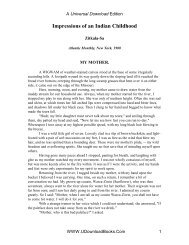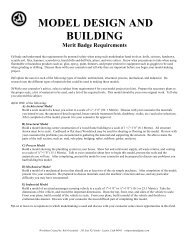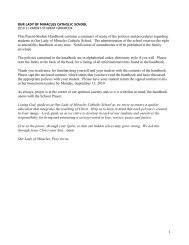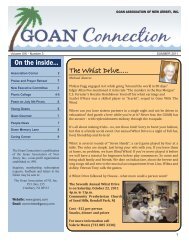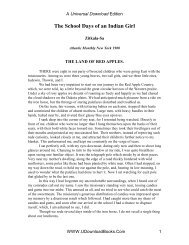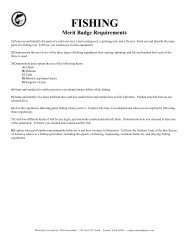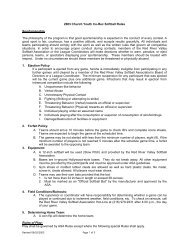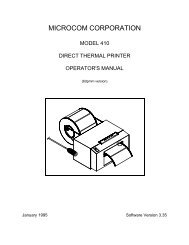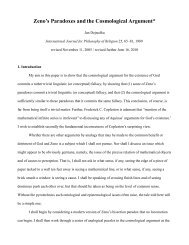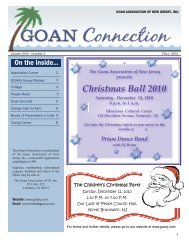Dummett's Backward Road to Frege and to Intuitionism - Tripod
Dummett's Backward Road to Frege and to Intuitionism - Tripod
Dummett's Backward Road to Frege and to Intuitionism - Tripod
Create successful ePaper yourself
Turn your PDF publications into a flip-book with our unique Google optimized e-Paper software.
entities in different categories, we will all be in trouble, except for kind-monists. This is not <strong>to</strong> mention<br />
how tightly <strong>Frege</strong> ties linguistic function <strong>to</strong> on<strong>to</strong>logical category. Thus the best gloss is that <strong>to</strong>nes are<br />
emergent entities for <strong>Frege</strong>. And if <strong>to</strong>nes are a special kind of emergent entities, this would provide an<br />
excellent explanation of why they are a unique category. It would also remove the mystery about their<br />
nature. For the concept of an emergent entity is a merely logical concept. An emergent entity is merely<br />
an entity that has at least one property none of its logical constituents has.<br />
Similarly for forces. <strong>Frege</strong> says assertion is the objective communication of a judgment, where a<br />
judgment is an indefinable sort of inward recognition (1979e: 139; 1968a: 513; see 1970f: 65; 1970e:<br />
126, 126 n.*). A very plausible gloss would be that forces are really kinds of objective speech acts,<br />
namely acts which communicate inward states such as recognition or query. This is plausible because<br />
the assertion sign (judgment stroke) is part of the objectively communicable formal notation. That<br />
would place forces on the objective side of the house. But if so, my criticism of <strong>Frege</strong> is that this only<br />
sweeps the emergent nature of forces under the rug. Taken by themselves, neither the objective nor the<br />
subjective components of assertions are outward communications of inward recognitions. Such<br />
communication is essentially relational <strong>and</strong> clearly an emergent property. Thus the best gloss is that<br />
forces are emergent entities for <strong>Frege</strong>. But we already know assertion cannot be an object or a function.<br />
For <strong>Frege</strong> says the assertion sign (judgment stroke) cannot function as a name, on pain of reducing<br />
assertions <strong>to</strong> suppositions (Grundgesetze vol. 1, § 5; see 1968a: 514); <strong>and</strong> we have seen how tightly he<br />
ties linguistic function <strong>to</strong> on<strong>to</strong>logical category.<br />
Thus <strong>to</strong>nes <strong>and</strong> forces are unique categories; they are irreducible <strong>to</strong> each other. But we can<br />
“take” them “as” objects by first “taking” their subjective components “as” objects, <strong>and</strong> thus refer <strong>to</strong><br />
them as easily as we can refer <strong>to</strong> ideas. I call this a “double take” (pun intended). Thus the second<br />
model seems workable for <strong>to</strong>nes <strong>and</strong> forces, if <strong>Frege</strong>’s single take works. 32<br />
The third model is best. <strong>Frege</strong>’s <strong>to</strong>nes, forces, <strong>and</strong> verbal explications are part of speech as<br />
59




